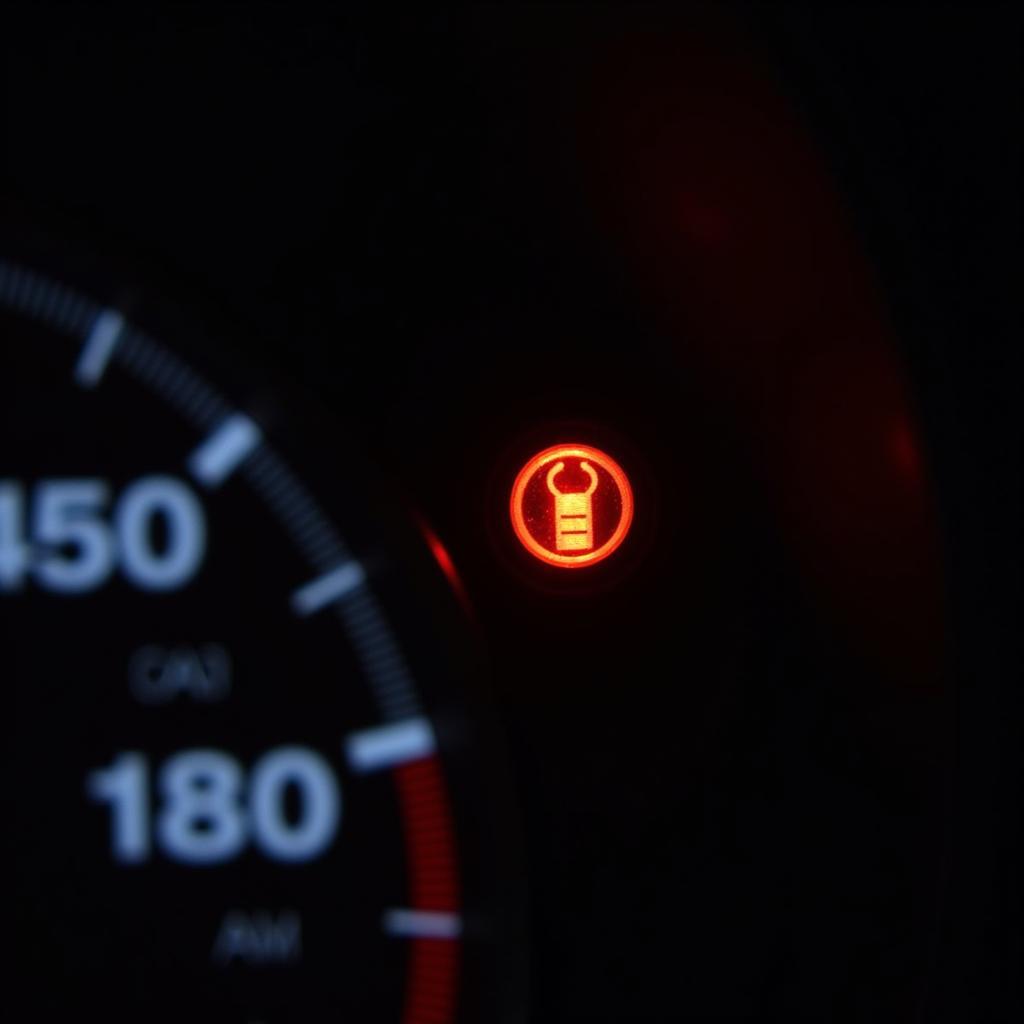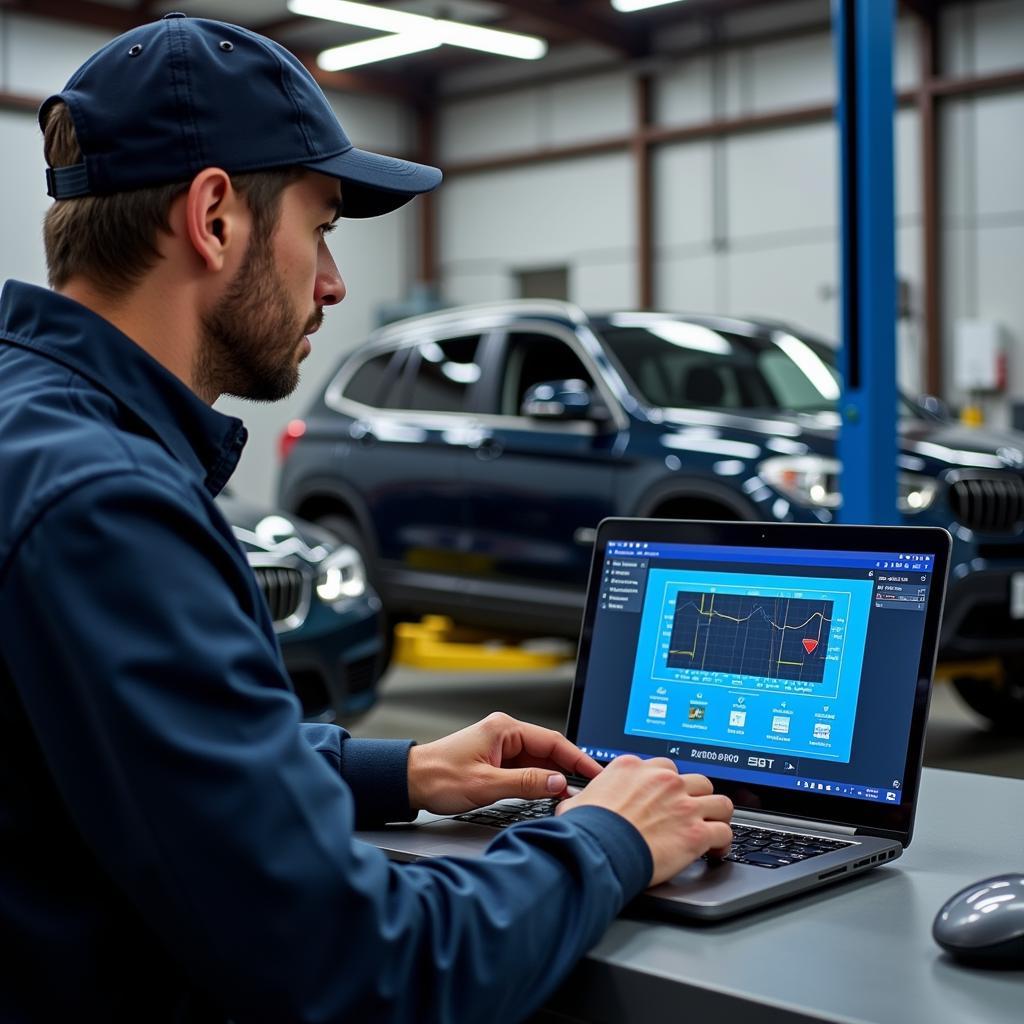The brake warning indicator light on your dashboard is a crucial safety feature. When illuminated, it signals a potential issue within your braking system that requires immediate attention. Ignoring this warning light could lead to reduced braking performance and increase the risk of an accident.
Understanding Your Brake Warning Indicator Light
 Brake warning light illuminated on a car dashboard
Brake warning light illuminated on a car dashboard
The brake warning light typically appears as a red circle with an exclamation mark or the word “BRAKE” in the center. While the specific design may vary between car manufacturers, its purpose remains consistent: to alert the driver of a problem within the braking system.
Common Reasons Your Brake Warning Light Is On
Several factors can trigger your brake warning indicator light. These include:
- Low Brake Fluid Level: This is one of the most common reasons for the light to illuminate. Brake fluid is essential for transmitting force from the brake pedal to the wheels, and a leak in the system can significantly reduce braking efficiency.
- Worn Brake Pads: Brake pads are designed to wear down over time. When they reach a certain thickness, the brake warning light serves as a reminder to replace them.
- Faulty Brake Caliper: The brake caliper houses the brake pads and pistons. A malfunctioning caliper can prevent the brakes from releasing properly, causing the warning light to come on.
- ABS Issue: If your vehicle has an anti-lock braking system (ABS), a problem with this system can also trigger the warning light. This could be due to a faulty sensor, control module, or wiring issue.
- Parking Brake Engaged: In some vehicles, leaving the parking brake even partially engaged can trigger the brake warning light.
What to Do When Your Brake Warning Indicator Light Comes On
If your brake warning light comes on, it’s crucial to take immediate action:
- Safely Pull Over: Find a safe location to stop your vehicle as soon as possible. Avoid sudden braking and turn on your hazard lights to alert other drivers.
- Check Your Parking Brake: Ensure that your parking brake is fully disengaged. If it was partially engaged, disengaging it might be enough to turn off the warning light.
- Inspect Brake Fluid Level: If the parking brake isn’t the issue, carefully check the brake fluid level in the reservoir. Refer to your owner’s manual for the location and recommended fluid type. If the level is low, adding brake fluid might temporarily address the issue, but it’s crucial to have the system inspected for leaks.
- Avoid Driving Further: If the brake fluid level is significantly low, you notice a leak, or the warning light remains illuminated, do not attempt to drive your vehicle. Contact a qualified mechanic or tow your vehicle to a trusted repair shop for a professional diagnosis.
Remote Diagnostics and Software Solutions for Brake Warning Lights
In today’s technologically advanced automotive landscape, remote diagnostics and software solutions play an increasingly vital role in diagnosing and resolving brake warning light issues.
“Remote diagnostics allow us to access a vehicle’s onboard computer system from anywhere,” says John Smith, Senior Automotive Engineer at XYZ Auto Technologies. “This allows us to quickly identify the root cause of the brake warning light, whether it’s a faulty sensor, a software glitch, or a mechanical problem.”
 Mechanic using a laptop for remote car diagnostics in a repair shop
Mechanic using a laptop for remote car diagnostics in a repair shop
In some cases, a simple software update can resolve the issue. For instance, if the Passat brake warning indicator light is on due to a known software glitch, a remote software update can be implemented without the need to physically visit a repair shop.
Preventative Maintenance for a Healthy Braking System
Regular maintenance is key to preventing brake warning light issues and ensuring the longevity and optimal performance of your vehicle’s braking system.
- Brake Fluid Flush: Brake fluid is hygroscopic, meaning it absorbs moisture over time. This can lead to corrosion and reduced braking performance. It is recommended to flush your brake fluid every 2-3 years or as recommended in your owner’s manual.
- Brake Pad Inspection: Have your brake pads inspected at least once a year or more frequently if you drive in demanding conditions.
- Listen for Unusual Noises: Pay attention to any screeching, grinding, or squealing sounds coming from your brakes, as these can be early indicators of a problem.
Conclusion
The brake warning indicator light is a critical safety feature in your vehicle. Understanding its significance and taking prompt action when it illuminates can prevent costly repairs and, most importantly, keep you safe on the road. By following the guidelines outlined in this article and adhering to a regular maintenance schedule, you can ensure your braking system remains in optimal condition for miles to come.

